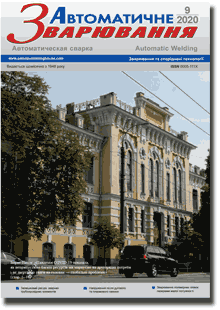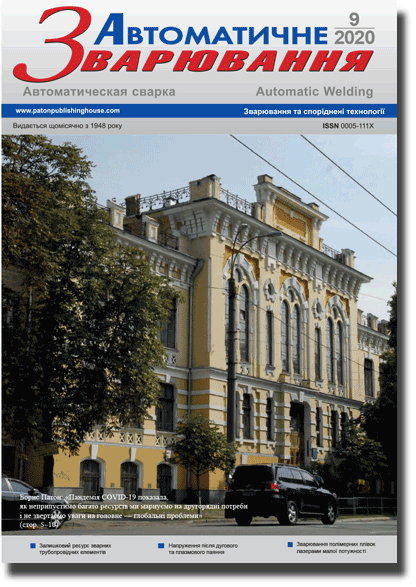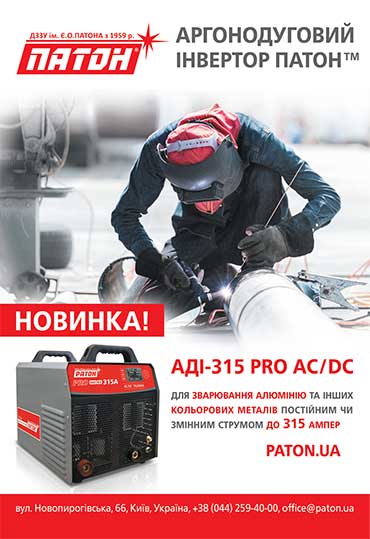| 2020 №09 (04) |
DOI of Article 10.37434/as2020.09.05 |
2020 №09 (06) |

"Avtomatychne Zvaryuvannya" (Automatic Welding), #9, 2020, pp. 42-46
Residual stresses in thin-sheet zinc-coated steel joints after arc welding and plasma brazing
S.V. Maksymova1, I.V. Zvolinskyy1, V.V. Yurkiv1, S.N. Minakov2, V.V. Lysak2
1E.O. Paton Electric Welding Institute of the NAS of Ukraine. 11 Kazymyr Malevych Str., 03150, Kyiv, Ukraine. E-mail: office@paton.kiev.ua
2NTU «Igor Sikorsky Kyiv Polytechnic Institute». 37 Peremohy Ave., 03056, Kyiv, Ukraine
In the manufacture of thin-walled structures by welding, residual stresses appear in them, which negatively affect the geometric parameters and quality of the obtained products. The paper presents the results of evaluation of residual stresses on simulator-samples made from galvanized steel 08ps (semi-killed) after MAG welding, and plasma brazing using constant and modulated current. Lowering of residual stresses and avoidance of brazing filler metal spattering are promoted by reduction of heat input, when making permanent joints. One of the ways contributing to it, is application of plasma brazing, which provides the ability of setting the current, independently of filler material feed rate. Determination of the magnitude of residual stresses in the joints was performed by the magnetoelastic method. It is shown that in plasma brazing with constant current the dimensions of plastic deformation zone are much smaller than in MAG welding, which is associated with a decrease in the amount of thermal energy applied to the metal. Plasma brazing with constant current allows lowering residual stresses from 149, which is obtained by welding, to 119 MPa. Further decrease of residual stresses (to 85 MPa) during plasma brazing of joints of galvanized steel 08ps is possible due to the use of modulated current. 18 Ref, 5 Fig..
Keywords: MAG welding, plasma brazing, modulated current, residual stresses, shrinkage force, plastic deformation, elastic deformation, heat input, zinc-coated steel, magnetoelastic method
Received: 07.08.2020
References
1. Kozlov, S.V., Kirillov, Yu.V. (2009) Application of plasma welding as the method for lowering of residual strains and stresses in steel welded structures. In: Collect. of V.M.Shimanovsky Ukrniiproektstalkonstruktsiya, 3, 102-107 [in Russian].2. Monfared, A.Kh., Panteleenko, A.F. (2011) Mathematical modeling of welding deformations in thin plates. Vestnik BNTU, 5, 19-25 [in Russian].
3. William N. (2008) Sringer Handbook of Experimental Solid Mechanics. Reference work. Springer US. https://doi.org/10.1007/978-0-387-30877-7
4. Paton B.E. (2000) Plasma technology at the turn of the century. The Paton Welding J., 12, 3-5.
5. Sitnikov, B.V. (2012) Influence of pulsed-arc welding parameters on distribution of residual stresses in AMg6 joints. Energosberezhenie, Energetika, Energoaudit, 8, 102, 69-74 [in Russian].
6. Robert K. (2005) Plasma brazing - Advantages and disadvantages compared with MIG brazing. Welding and Cutting, 4, 3, 147-149.
7. Pavol Sejc (2010) MAG zvaranie pozinkovanych plechov v ochrannom plyne CO2 a Ar+18%CO2. Zvarac, VII, 3, 8-13.
8. Pavol Sejc (2002) Oblukove zvaranie MAG ocelovych plechov pokrytych protikoroznym naterrom na baze zinku. Zvaranie-Svarovani. 3, 4, 71-73.
9. Shonin V.A., Mashin V.S., Khaskin V.Yu., Nedej T.N. (2006) Residual stresses in butt joints of thin sheets from alloy AMg6 after arc and laser-arc welding. The Paton Welding J., 9, 20-24.
10. Makhnenko O.V, Muzhichenko A.F., Prudky I.I. (2013) Mathematical modelling of stress-strain state of welded panels from titanium alloy VT20. Ibid, 2, 13-19.
11. Methontsev, Yu.Ya. (1986) Sensor of magnetic anisotropy. USSR author`s cert. Int. Cl. 2 G01N27/86 [in Russian].
12. Minakov, S.M. (2012) Determination of state of main pipelines by magnetoanisotropic method. In: Syn. of Thesis for Cand. of Techn. Sci. Degree. Kyiv [in Russian].
13. Trochun, I.P. (1964) Internal forces and deformations in welding. Moscow, Mashgiz [in Russian].
14. Vinokurov, V.A. (1968) Welding strains and stresses. Moscow, Mashinostroenie [in Russian].
15. Kasatkin, B.S., Prokhorenko, O.V., Chertov, I.M. (1987) Strains and stresses in welding. Kiev, Vyshcha Shkola [in Russian].
16. Prokhorenko, V.M., Prokhorenko, O.M. (2009) Stresses and strains in welded joints and structures: Manual. Kyiv, NTU [in Ukrainian].
17. Nikolaev, G.A., Kurkin, S.A., Vinokurov, V.A. (1982) Welded structures. Strength of welded joints and deformations of structures: Manual. Book 1. Moscow, Vysshaya Shkola [in Russian].
18. Nurguzhin M., Danenova G., Akhmetzhanov T. (2019) Computer Modeling of Residual Stresses and Strains at Arc Welding by Modulated Current. Proceedings of the 4th International Conference on Industrial Engineering. ICIE 2018. Lecture Notes in Mechanical Engineering. Springer, https://doi.org/10.1007/978-3-319-95630-5_265
Advertising in this issue:
The cost of subscription/purchase order journals or individual articles
| Journal/Currency | Annual Set | 1 issue printed |
1 issue |
one article |
| TPWJ/USD | 384 $ | 32 $ | 26 $ | 13 $ |
| TPWJ/EUR | 348 € | 29 € | 24 € | 12 € |
| TPWJ/UAH | 7200 UAH | 600 UAH | 600 UAH | 280 UAH |
| AS/UAH | 1800 UAH | 300 UAH | 300 UAH | 150 UAH |
| AS/USD | 192 $ | 32 $ | 26 $ | 13 $ |
| AS/EUR | 180 € | 30 € | 25 € | 12 € |
| SEM/UAH | 1200 UAH | 300 UAH | 300 UAH | 150 UAH |
| SEM/USD | 128 $ | 32 $ | 26 $ | 13 $ |
| SEM/EUR | 120 € | 30 € | 25 € | 12 € |
| TDNK/UAH | 1200 UAH | 300 UAH | 300 UAH | 150 UAH |
| TDNK/USD | 128 $ | 32 $ | 26 $ | 13 $ |
| TDNK/EUR | 120 € | 30 € | 25 € | 15 € |
AS = «Automatic Welding» - 6 issues per year;
TPWJ = «PATON WELDING JOURNAL» - 12 issues per year;
SEM = «Electrometallurgy Today» - 4 issues per year;
TDNK = «Technical Diagnostics and Non-Destructive Testing» - 4 issues per year.








